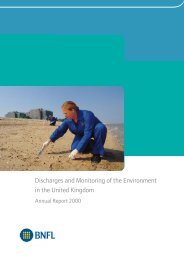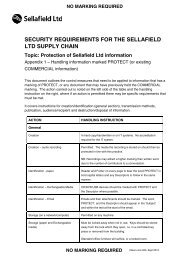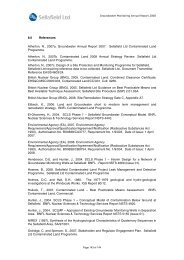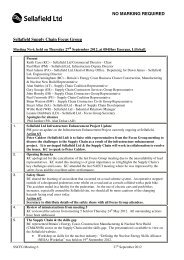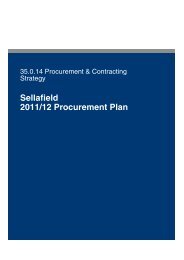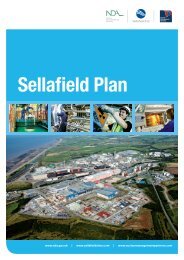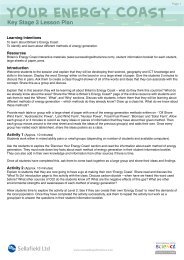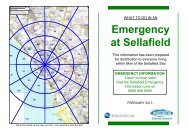Annual Report for 2010/11 and Forward Programme - Sellafield Ltd
Annual Report for 2010/11 and Forward Programme - Sellafield Ltd
Annual Report for 2010/11 and Forward Programme - Sellafield Ltd
Create successful ePaper yourself
Turn your PDF publications into a flip-book with our unique Google optimized e-Paper software.
SSEM/20<strong>11</strong>/4730 June 20<strong>11</strong>Work commenced following a start-up meeting between SL <strong>and</strong> the contractors in February<strong>2010</strong>, with early focus concentrating on delivery of tasks 1, 3 & 6, with delivery of tasks 2, 4 &5 scheduled <strong>for</strong> later in the programme.Un<strong>for</strong>tunately <strong>and</strong> unexpectedly, WSC went out of business during the summer of <strong>2010</strong>,resulting in the collapse of the hydrodynamic modelling contract, presenting SL with anumber of problems, both in relation to delivery of the above; <strong>and</strong> other work <strong>for</strong> the site thatwas reliant on the services of WSC.This contract had been in place <strong>for</strong> approximately six months when WSC went intoadministration, meaning that work had started on all of the tasks. At that time task 6 hadbeen completed by WSC; <strong>and</strong> tasks 1 & 3 were well underway with Cefas. Cefas had alsostarted some of the evaluation work to deliver task 5. Tasks 2 <strong>and</strong> 4 were to be deliveredthrough collaborative ef<strong>for</strong>t between WSC <strong>and</strong> Cefas <strong>and</strong> were in the early preparatorystages, being reliant on output from the other tasks to be completed.A major part of the work to improve the modelling was the gathering of new field data, inparticular the deployment of equipment onto the seabed to measure bed shear stress as partof task 3. In June <strong>2010</strong> an Aquadopp current profiler was deployed onto the seabed close tothe end of the existing sea pipeline diffusers. The plan was <strong>for</strong> a total deployment period ofapproximately six months. With a typical operating battery life lasting between 60 <strong>and</strong> 90days, the total deployment would be achieved by replacing the Aquadopp every 2 months(weather permitting). At the time of WSC folding, Cefas had the first Aquadopp in the watercollecting data <strong>and</strong> the timeframe <strong>for</strong> the first service/replacement visit was approaching.Without a contract in place there was a real risk that the Aquadopp work would not becompleted <strong>and</strong> a number of reports under preparation <strong>for</strong> other tasks would not be issued.The contract in place <strong>for</strong> the work was between SL <strong>and</strong> WSC; <strong>and</strong> due to the collaborativeelements of the contract, it was not legitimate on commercial grounds to re-award or transferthe remainder of the total contract directly to Cefas. However, the fact that equipment(Aquadopp <strong>and</strong> frame) had already been deployed <strong>and</strong> reports <strong>for</strong> other tasks were alreadybeing prepared by Cefas, meant that a limited contract was considered to be legitimate,allowing the ‘Cefas-only’ elements of the contract, that were already underway, to becompleted.Inevitably the need to prepare <strong>and</strong> issue a new contract did introduce delays <strong>for</strong> receipt offinal reports, against the original schedule, <strong>and</strong> has led to a re-think on the approach beingtaken <strong>for</strong> offshore monitoring. That said, the progress made against the completed tasks ofthe contract is reported below. Due to the collapse of the contract with WSC no progress isreported against tasks 2, 4 <strong>and</strong> 5. Discussion on the impacts of the failure to deliver thiswork can be found in Section 7.3 setting out the <strong>for</strong>ward programme <strong>for</strong> offshorecharacterisation <strong>and</strong> monitoring.3.3.2 Progress on analysis <strong>and</strong> interpretation of existing swath bathymetry dataIn the <strong>2010</strong> update report, SL reported the initial findings from the Cefas analysis <strong>and</strong>interpretation of the existing swath bathymetry data (see Figure 3.32), indicating that the datadid not fully satisfy the requirements of the transport <strong>and</strong> dispersion modelling work.In December <strong>2010</strong>, Cefas were able to provide the finalised report on the swath bathymetrydata review; <strong>and</strong> provided the following conclusions:© Nuclear Decommissioning Authority 20<strong>11</strong>. 65



